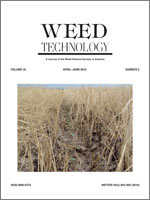Broadleaf weeds and nutsedge are persistent problems with limited management options for strawberry growers in Florida. Experiments were conducted in 2012 to 2013 (year 1) and 2013 to 2014 (year 2) at the Gulf Coast Research and Education Center in Wimauma, FL, to evaluate tolerance of two strawberry cultivars (‘Strawberry Festival' and ‘WinterStar'TM) to PRE herbicides applied on the bed top or injected through the drip tape. The bed-top herbicides were applied to formed beds following fumigation but prior to laying the plastic mulch. Herbicides evaluated included two rates of EPTC, fomesafen, halosulfuron, and S-metolachlor as well as tank mixes of EPTC S-metolachlor, fomesafen S-metolachlor, and napropamide oxyfluorfen. Drip-applied herbicides were applied through a single drip tape and strawberries were transplanted 1, 7, 15 and 30 d following application. Drip-applied herbicides included two rates of EPTC and fomesafen as well as two rates of a tank mix of napropamide oxyfluorfen. None of herbicides applied on the bed top except S-metolachlor 214 g ai ha−1 consistently injured either strawberry cultivar or impacted yields. None of the drip-applied herbicides damaged the strawberry plants or reduced yields at all planting dates. In year 1, EPTC at 229 g ai ha−1 and EPTC at 229 g ha−1 S-metolachlor at 107 g ha−1 resulted in a 70 to 86% reduction in purple nutsedge density compared to the nontreated control. No differences in nutsedge density among treatments were observed in year 2. The herbicides evaluated are safe for use on strawberry and would provide growers with alternative herbicide options, application timings, and application techniques. Further research is needed to evaluate efficacy.
Nomenclature: EPTC; fomesafen; halosulfuron; napropamide; S-metolachlor; purple nutsedge, Cyperus rotundus L.; strawberry, Fragaria × ananessa Duchesne ‘Strawberry Festival' and ‘WinterStar'TM.
Malezas de hoja ancha y Cyperus rotundus son problemas persistentes con limitadas opciones de manejo para los productores de fresa de Florida. Experimentos fueron realizados desde 2012 a 2013 (año 1) y desde 2013 a 2014 (año 2) en el Centro de Investigación y Educación de la Costa del Golfo, en Balm, FL, para evaluar la tolerancia de dos cultivares de fresa ('Strawberry Festival' y 'WinterStar'™) a herbicidas PRE aplicados sobre la superficie de la cama de siembra o inyectados a través de la cinta de riego por goteo. Los herbicidas sobre la cama de siembra fueron aplicados a camas formadas después de la fumigación pero antes de instalar la cobertura plástica. Los herbicidas evaluados incluyeron dos dosis de EPTC, fomesafen, halosulfuron, y S-metolachlor, además de mezclas en tanque de EPTC S-metolachlor, fomesafen S-metolachlor, y napropamide oxyfluorfen. Los herbicidas aplicados con el sistema de riego fueron aplicados a través de una sola cinta de goteo y las fresas fueron trasplantadas 1, 7, 15, y 30 d después de la aplicación. Los herbicidas aplicados con el riego por goteo incluyeron dos dosis de EPTC y fomesafen además de dos dosis de una mezcla en tanque de napropamide oxyfluorfen. Ninguno de los herbicidas aplicados sobre la cama, excepto S-metolachlor a 214 g ai ha−1, dañó consistentemente a los cultivares de fresa ni impactaron su rendimiento. Ninguno de los herbicidas aplicados con el riego por goteo dañó a las plantas de fresa ni redujo su rendimiento en cualquiera de las fechas de siembra. En el año 1, EPTC a 229 g ai ha−1 y EPTC a 229 g ha−1 S-metolachlor a 107 g ha−1 resultaron en una reducción de 70 a 86% en la densidad de C. r





